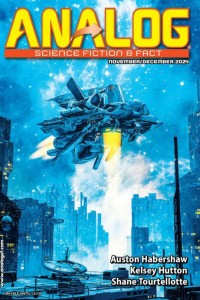Gardner Dozois reviews Short Fiction, June 2016
Asimov’s 4-5/16
Tor.com 1/6/16 – 4/13/16
Lightspeed 4/16
Slate 4/26/16
 The April/May Double Issue of Asimov’s is a substantial one, full of good stories, almost all of them core SF. Probably few if any will make awards ballots next year, but taken together in entertainment value they make the issue more than worth the money it takes to buy it. The best story here is also the most ambitious one: ‘‘Flight from the Ages’’ by Derek Künsken, a story taking place over a timespan of billions of years (ultimately all the way back to the beginning of the universe), in which a banking IA operating a customs and tariff spaceship tries to deal with the inadvertent release of unimaginably powerful forces from an ancient alien weapon of war that threatens to destroy not only our galaxy but all of spacetime. There’s some great and very original conceptualization here, although as there are no human protagonists and a number of chewy scientific infodumps to get through, some readers may find it a bit abstract or austere. Stick with it and your persistence will be rewarded by a pure dose of that Sense of Wonder stuff that science fiction is supposed to deliver. Also good in April/May is Kristine Kathryn Rusch’s ‘‘Matilda’’, which deals with the dysfunctional relationship between a human pilot and another, AI-operated sentient spaceship, and how they have to learn to function with each other in order to survive a dangerous mission in enemy territory. Another spaceship pilot (although the ships here function more like tugboats than what we usually think of as spaceships) is at the heart of new writer Suzanne Palmer’s long novella ‘‘Lazy Dog Out’’. She is a tough, formerly homeless woman whose job it is to shepherd bigger spaceships in and out of a planet’s huge docking facility, a city in its own right, who finds herself embroiled in a sinister conspiracy that threatens not only the station’s impoverished homeless population (with whom she’s maintained some contact) but her own life and the existence of everything she holds dear. This is a rare example in science fiction of a story that features someone in what is more-or-less a blue collar job. Most SF centers around the upper classes: professional people, rich people, executives, scientists, celebrities, politicians, if not the actual aristocracy themselves – not necessarily royals, but whoever the aristocracy of that society may be. The story is well told and suspenseful, although I did find it odd that the docking facility was planet-bound, where you have to push the big ships up out of a gravity well with your ‘‘tugboats,’’ rather than a station in space. Robert Reed’s ‘‘The Days of Hamelin’’ is the melancholy story of an unknown plague that starts killing children, and how the surviving children are affected emotionally and psychologically by having been passed over. T.R. Napper’s ‘‘Flame Trees’’ is a grueling story about an emotionally scarred veteran of a future war trying to hang on to the memories of the horrors he’s seen in the face of well-meaning governmental attempts to take them from him, in spite of the fact that the PTSD they generate makes it impossible for him to truly function in society.
The April/May Double Issue of Asimov’s is a substantial one, full of good stories, almost all of them core SF. Probably few if any will make awards ballots next year, but taken together in entertainment value they make the issue more than worth the money it takes to buy it. The best story here is also the most ambitious one: ‘‘Flight from the Ages’’ by Derek Künsken, a story taking place over a timespan of billions of years (ultimately all the way back to the beginning of the universe), in which a banking IA operating a customs and tariff spaceship tries to deal with the inadvertent release of unimaginably powerful forces from an ancient alien weapon of war that threatens to destroy not only our galaxy but all of spacetime. There’s some great and very original conceptualization here, although as there are no human protagonists and a number of chewy scientific infodumps to get through, some readers may find it a bit abstract or austere. Stick with it and your persistence will be rewarded by a pure dose of that Sense of Wonder stuff that science fiction is supposed to deliver. Also good in April/May is Kristine Kathryn Rusch’s ‘‘Matilda’’, which deals with the dysfunctional relationship between a human pilot and another, AI-operated sentient spaceship, and how they have to learn to function with each other in order to survive a dangerous mission in enemy territory. Another spaceship pilot (although the ships here function more like tugboats than what we usually think of as spaceships) is at the heart of new writer Suzanne Palmer’s long novella ‘‘Lazy Dog Out’’. She is a tough, formerly homeless woman whose job it is to shepherd bigger spaceships in and out of a planet’s huge docking facility, a city in its own right, who finds herself embroiled in a sinister conspiracy that threatens not only the station’s impoverished homeless population (with whom she’s maintained some contact) but her own life and the existence of everything she holds dear. This is a rare example in science fiction of a story that features someone in what is more-or-less a blue collar job. Most SF centers around the upper classes: professional people, rich people, executives, scientists, celebrities, politicians, if not the actual aristocracy themselves – not necessarily royals, but whoever the aristocracy of that society may be. The story is well told and suspenseful, although I did find it odd that the docking facility was planet-bound, where you have to push the big ships up out of a gravity well with your ‘‘tugboats,’’ rather than a station in space. Robert Reed’s ‘‘The Days of Hamelin’’ is the melancholy story of an unknown plague that starts killing children, and how the surviving children are affected emotionally and psychologically by having been passed over. T.R. Napper’s ‘‘Flame Trees’’ is a grueling story about an emotionally scarred veteran of a future war trying to hang on to the memories of the horrors he’s seen in the face of well-meaning governmental attempts to take them from him, in spite of the fact that the PTSD they generate makes it impossible for him to truly function in society.
Also in April/May, C.W. Johnson rationalizes the old fantasy tale about a whale so big that it has the shipwrecked sailors it’s swallowed living in its belly as SF, with mixed results in ‘‘Of the Beast in the Belly’’. I must admit that I was longing for the characters to get out of the alien ‘‘whale’s’’ belly long before they actually did, as those scenes dragged a bit for me. In ‘‘The Return of Black Murray’’, Alexander Jablokov brings us along for the reunion in a now abandoned amusement park of old high-school friends whose lives were changed forever by one traumatic event that took place there one hot summer night many years before. This probably would have worked better as a mainstream story, with some more mundane reason for the tragic breakup of the classmates’s friendship, than it does with the rather trumped-up and unconvincing fantastic element that appears toward the end of the story. ‘‘Three Paintings’’ by James Van Pelt deals with an artist coming to the slow realization that he’s unintentionally involved in a elaborate art scam, somewhat reduced in impact for me by the fact that I find it hard to believe that he’d agree to put himself in the situation he’s in in the first place, one where he kills himself for the sake of increased creativity. The issue’s only fantasy, Esther M. Friesner’s ‘‘Woman in the Reeds’’, is not one of Friesner’s more familiar comic fantasy tales, but rather a rather grim story about a mother struggling to save her baby from a malign supernatural Entity.
Since they started posting new stories on January 6, the first nine stories to appear on Tor.com were fantasy stories of one sort or another, listed as fantasy, dark fantasy, urban fantasy, and epic fantasy. Some of these were good stories, such as ‘‘The Glass Galago’’ by A.M. Dellamonica, ‘‘Two’s Company’’ by Joe Abercrombie, ‘‘The Maiden Thief’’ by Melissa Marr, and ‘‘Breaking Water’’ by Indrapramit Das, but the lack of science fiction stories was beginning to worry me, as SF had been somewhat light on the ground at Tor.com in 2015 as well, and I didn’t want to see it disappear from the site for good. Other than a pleasant steampunk Sherlock Holmes pastiche, ‘‘The Great Detective’’ by Delia Sherman, the first stories on Tor.com that could reasonably be called core science fiction didn’t begin to show up until toward the end of March – but at least they were good ones when they did appear. An argument could be made that ‘‘Listen’’ by Karin Tidbeck, a sequel to her previous story ‘‘Sing’’, is science fantasy rather than science fiction per se; as with the previous story, it’s expertly crafted and features psychologically complex characters, but I find the science here – a moon that emits ‘‘radiations’’ that in some unexplained way cause human beings to lose the ability to speak when it’s in the sky – dubious at best, more a poetic conceit than something that would actually be able to happen in the real world. There’s no doubt about the classification of ‘‘That Game We Played During the War’’ by Carrie Vaughn, though – it’s undoubtedly SF, and a good example of the form, taking us to a planet where a debilitating war between two races, one telepathic and the other not, has just ended, and the playing of a simple game of chess becomes a bridge, strengthening the still-uneasy peace, as it’s played by two individuals who had once been prisoners of war, each held captive by the other’s people. Even stronger is ‘‘Terminal’’ by Lavie Tidhar, a touching portrait of the ordinary people (some of whom have terminal illnesses, some who do not) who accept the government’s offer of a one-way trip to Mars. This is beautifully written and beautifully felt, deeply emotional, and certainly one of the best stories of the year to date.
Carrie Vaughn, in a less serious mode, also provides the best story in the April Lightspeed, ‘‘Origin Story’’, concerning a woman who discovers that her old high-school boyfriend has become a bank-robbing supervillain, in a comic book-inspired world where superheroes and super villains, and the epic battles between them, are common; it’s good fun. Also in April, Patricia Strand does a good job in ‘‘The Birth Will Take Place on a Mutually Acceptable Research Vessel’’, in working out the implications, complications, and unexpected political consequences of the birth of a child with a human mother and an alien father – but she never deals with the issue of how such a pregnancy could be possible in the first place, a subject that’s never even raised in the course of the story.
An example of a first-rate SF story popping up unexpectedly in an unusual place is ‘‘Mika Model’’ by Paolo Bacigalupi, which appeared in the April 26 issue of Slate, which doesn’t usually run fiction. This is a gripping story about an AI-run sex robot that kills ‘‘her’’ owner; is it murder, or is it just product malfunction? This territory has been covered before, notably in Elizabeth Bear’s ‘‘Dolly’’ from 2011, but Bacigalupi does an excellent job of exploring the issue of machine sentience and its implications for the relationships between humans and robots/AIs – something that may not remain the province of science fiction for long, as we continue to hurtle (sometimes, it seems, with accelerating speed) into the unknown territory of the 21st century.




